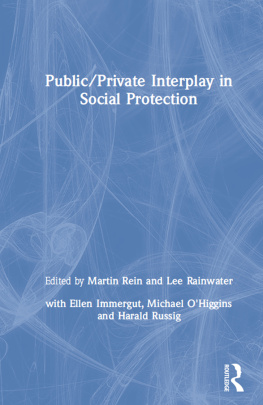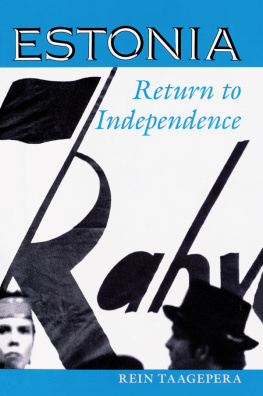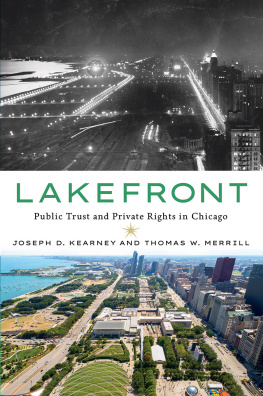Public/Private Interplay in Social Protection
Comparative Public Policy Analysis Series
Series Editors
Martin Rein, Massachusetts Institute of Technology
Lee Rainwater, Harvard University
PUBLIC/PRIVATE INTERPLAY IN SOCIAL PROTECTION
Martin Rein and Lee Rainwater, Editors
THE SCANDINAVIAN MODEL: WELFARE STATES AND WELFARE RESEARCH
Robert Erikson, Erik Jrgen Hansen, Stein Ringen, and Hannu Uusitalo, Editors
STAGNATION AND RENEWAL IN SOCIAL POLICY
Martin Rein, Gsta Esping-Andersen, and Lee Rainwater, Editors
Public/Private Interplay in Social Protection
A COMPARATIVE STUDY
EDITED BY
MARTIN REIN and LEE RAINWATER
with Ellen Immergut, Michael OHiggins and Harald Russig
First published 1986 by M.E. Sharpe.Inc
Published 2016 by Routledge
2 Park Square, Milton Park, Abingdon, Oxon OX14 4RN
711 Third Avenue, New York, NY 10017, USA
Routledge is an imprint of the Taylor & Francis Group, an informa business
Copyright 1986 by Taylor & Francis. All rights reserved.
No part of this book may be reprinted or reproduced or utilised in any form or by any electronic, mechanical, or other means, now known or hereafter invented, ncluding photocopying and recording, or in any information storage or retrieval system, without permission in writing from the publishers.
Notices
No responsibility is assumed by the publisher for any injury and/or damage to persons or property as a matter of products liability, negligence or otherwise, or from any use of operation of any methods, products, instructions or ideas contained in the material herein.
Practitioners and researchers must always rely on their own experience and knowledge in evaluating and using any information, methods, compounds, or experiments described herein. In using such information or methods they should be mindful of their own safety and the safety of others, including parties for whom they have a professional responsibility.
Product or corporate names may be trademarks or registered trademarks, and are used only for identification and explanation without intent to infringe.
Library of Congress Cataloging-in-Publication Data
Public/private interplay in social protection.
(Comparative public policy analysis)
Includes bibliographies.
1. Social policy. 2. Welfare state. 3. Charities. 4. Employee fringe benefits. I. Rein, Martin. II. Rainwater, Lee.
HN18.P831986361.6186-11911
ISBN 0-87332-383-1
ISBN 13: 978-0-87332-383-3 (hbk)
Contents
Martin Rein and Lee Rainwater
Martin Rein and Lee Rainwater
Ellen Immergut
Michael OHiggins
Harald Russig
Martin Rein and Lee Rainwater
This book is written as a critique of the narrow focus on the welfare state. The main message of the study is simple: we need to look at all forms of social protection and not only at the activities of the state. The insight is so self-evident that we began to explore the factors, aside from the lack of easy access to good data, that might account for this systematic oversight. We believe that the main explanation lies in the existence of two intellectual traditions, one conventionally associated with the study of social policy and the other concerned with the analysis of labor and industrial relations. The former focused on state action, believing that nonstate action would be preversely redistributive. The latter concentrated on industrial conflict but neglected the content of these negotiations outside of monetary wages. We believe that the traditions of social policy and industrial relations must be reintegrated if we are to better understand and act on the world in which we live. This book is a first modest step toward such an intellectual reunification.
We approach our subject from three different perspectives: conceptual, empirical, and normative. Conceptually, we venture into the murky terrain of distinguishing between the public sector we associate with the welfare state and the private sector of enterprise-based social protection, conventionally called fringe benefits, and other nonprofit activities that are not associated directly with work, e.g., private charity. The boundary question turned out to be as fascinating as it was illusive. The state penetrates private activities and blurs the distinction between them. We believe this blurring of sectoral boundaries is an essential feature of the modern welfare state.
The second conceptual issue concerned the distinction between social protection and production. Are fringe benefits to be understood as extensions of wages or of social policy? How do we separate the systems of production and redistribution?
Empirically, we pursued a dual strategy of examining aggregate comparative quantitative data of trends in public and private provision in the United States and Europe. We wanted to locate the private within the public as best one could, given the limits of national data. But we also wanted to know more about the social process and general consequences of combining the public and private sectors. We selected three substantive areas; sickness, early retirement, and retirement. The issue of sick pay was especially interesting in Germany because payment and administration of the first six weeks of sickness benefits were transferred from the public to the private sector. We wanted to know why this happened and what difference it made.
If sickness was a case of the transfer from public to private, the German 59ers program was an illustration of how the private sector used the public sector to realize private aims of shedding its labor force without labor strife. A similar process was underway in Sweden, but on a much more modest level. Here industrial relations, labor market transfer, and social policy came together in reality, even though the intellectual traditions each represented remained apart.
Finally, we wanted to study contest, conflict, and competition as well as cooperation between the public and the private sectors. Pensions in Britain seemed an excellent illustration of this trend as British social policy invented opting out, a device permitting pensioners to transfer their public pension to the private sector. Against this background, the Swedish and German pension arrangements offered an informative contrast.
These case studies made it possible to study in depth three different dynamics in the public/private interplay: transfer from public to private; use of the public by the private; and competition and cooperation between the sectors.
We have not included an American case, but instead hope that the continental and Scandinavian cases will serve as background for a better understanding of the American situation. Some implications are drawn in the concluding chapter which pulls together and integrates the main findings of the case studies.
The conclusions also deal with normative questions and with implications for policy action. When we started this study with support from the Science Center in Berlin, we had a difficult time convincing people that these issues should not be regarded as settled but were indeed at the forefront of the policy debate. Events have proved us right. The normative debate about sectoral shifting and the political struggles over cost shifting are today very much the center of debate in a period of stabilization and decline in levels of spending. The direction that renewal might take is not clear. We offer some speculations in the concluding chapter where we review the case studies and speculate about its implications for policy.










